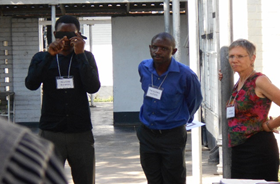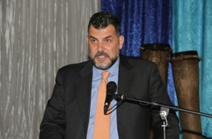Join a powerful, unprecedented alliance for better eye health for all.
Join IAPB-
Choose an alternate language here

There is need for such research to be done not only in Zimbabwe but in sub-Saharan Africa as a whole, as the data which currently exists is outdated and affects eye care planning. The RAAB is therefore an invaluable tool in collecting accurate and up to date data on the prevalence and causes of avoidable blindness.
Furthermore, before the RAAB, there was no data in Zimbabwe on the use of cataract services including surgical coverage and the outcome of performed cataract surgery both which are useful for planning and providing appropriate benchmarks to measure progress toward VISION 2020 goals.
In order to facilitate the successful implementation of the RAAB the pre-research RAAB protocol training and the selection of teams to conduct the research was instrumental and essential prerequisite for those who may wish to do similar research in the future.
The RAAB protocol training was held from the 22nd to the 26th of February 2016 in Mutare (Manicaland Province) and was facilitated by consultants from the University of Cape Town’s Community Eye Health Institute (UCT/CEHI). The five day training prepared the teams for data collection, essential in conducting research of this kind.

Data collection commenced on the 7th of March to the 7th of April, 2016. The RAAB data is collected from people of 50 years and older because the prevalence of blindness in the age group is higher. Data was collected from seventy–nine clusters sampled out of the eight districts in the Manicaland Province namely: Buhera, Chimanimani, Makoni, Mutare Urban, Mutare Rural, Mutasa, Nyanga and Chipinge Urban.
The teams were provided with tools for data collection and data was collected from 3 505 participants, out of 3 936 participants originally enrolled, over a period of 22 days. The data was collected using a standard pre-coded RAAB Survey software on mobile phones and data was forwarded to the Coordinator via email for downloading.

Another crucial part of the RAAB was the selection of segments from the clusters which was done with the support of village health workers and community leaders who assisted the cluster informers to map and select a segment from each cluster. Hence all people of 50 years and above residing in a selected segment were eligible to participate and the teams were requested to take visual acuity and lens examinations as part of the data collection process.
Data was collected by the Examiner and Assistant who were responsible for conducting the tests and entering the data. The Cluster Informers moved ahead of the Examiner in order to alert the cluster thereby engaging the village health workers in mapping and selecting the segment in preparation of the data collection. The village health workers were an important asset as they accompanied the data collection teams.
The results from the RAAB will primarily be disseminated to stakeholders by the Ministry of Health and Child Care (MoHCC) in Zimbabwe and will be instrumental in the planning, implementing and monitoring of eye care services in Zimbabwe. The data providing information on the prevalence of blindness, causes of blindness, cataract surgical coverage, barriers to accessing services and other indicators in Manicaland Province can be used to inform similar eye care planning in other provinces in Zimbabwe.

Author Email: [email protected]
Author Job Title: Programme Manager
CBM

Co-Author Email: [email protected]
Co-Author Title: Intern
CBM